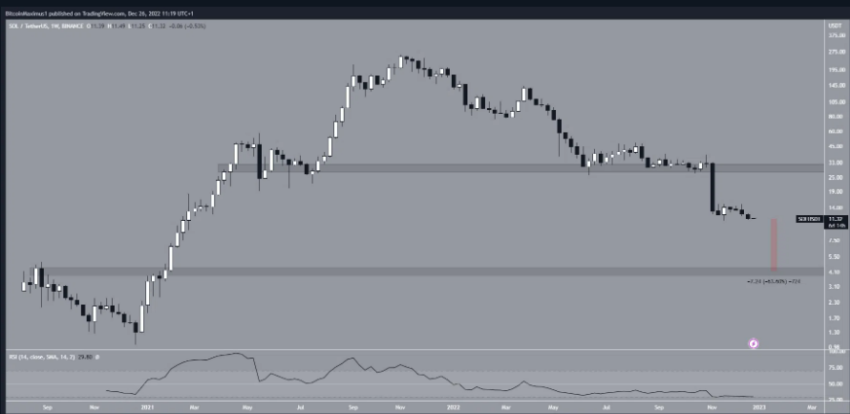
Crypto News: Sam Bankman-Fried headlines the most popular stories from across the cryptosphere, as featured on BeInCrypto this past week.
The week’s biggest news is that Sam Bankman-Fried was spotted at a JFK business lounge after his parents, two Stanford law professors, pledged their five-bedroom Palo Alto home as part of a $250 million bond agreement. Bankman-Fried’s luxurious surroundings attracted controversy on social media since the former crypto mogul faces $10 billion in fraud charges.
Sam Bankman-Fried Sighted After Signing Strict Bail Agreement
Litquidity tweeted photos of Sam Bankman-Fried working on a laptop after signing a $250 million bond agreement that will allow him to live with his parents in Palo Alto. Bankman-Fried was accompanied by parents Joe Bankman and Barbara Fried and several FBI employees.
His bail agreement is a non-cash recognizance bond that his parents and two non-family members cosigned.
Sam Bankman-Fried’s bail release is contingent on his receiving mental health counseling, substance abuse treatment, and wearing a monitoring bracelet. Additionally, he may not bear a firearm or spend more than $1,000 outside legal expenses.
If Sam Bankman-Fried violates his agreements of the bond, courts will seize his parents’ five-bedroom home in Palo Alto.
Investors Worry About BNB After FTT, a Token Created Sam Bankman-Fried
The collapse of Bankman-Fried’s crypto empire in Nov. 2022 was closely linked to a token called FTT that was created by his defunct exchange, FTX.
After a leaked financial statement revealed that large parts of the balance sheet of FTX affiliate Alameda Research were made up of illiquid FTT, Binance CEO Changpeng Zhao said Binance would sell its FTT holdings. His tweet sparked a bank run on FTX, causing FTT’s value to collapse. The SEC later ruled that the token was a security.
This week, concerned investors speculated whether Binance’s BNB token could be treated similarly because crypto exchanges delist tokens deemed securities.
Zhao and the crypto community said that BNB’s utility on the BNB Smart Chain distinguished it from FTT, which lost its utility after FTX fell.
The concerns from investors came after a court agreed with the SEC that LBC, the native token of the LBRY content distribution platform, was a security.
The SEC is also engaged in a battle with Ripple Labs and two of its executives for offering XRP as an unregistered security in 2020.
Decentralized Applications Suffer 74% Decline in TVL
With the SEC having its hands full with centralized cryptocurrency issuers and civilly charging Sam Bankman-Fried, the decentralized finance industry also took a beating this year.
The total value locked (TVL) in so-called layer one decentralized applications (dApps) fell sharply after the May 2022 collapse of algorithmic stablecoin TerraUSD rattled investor confidence in crypto.
So-called layer two protocols like Arbitrum and Optimism fared better, with Arbitrum NFTs gaining recognition in 2022. Sometimes called rollups, these layer-two chains execute transactions off the main chain, compressing select bits of transaction data and “rolling” them up to the main chain in a single batch.
On the upside, dApp developers’ weekly downloads of software libraries have increased tenfold since 2018. Despite this increase in developer interest, DeFi’s overall TVL dropped from $211.4 billion to $55 billion in Dec. 2022.
Bucking the DeFi downtrend, NFT trading volume rose 0.41% in 2022, with the number of unique traders rising by 876%. NFT sales increased by 10.6% as several Web 2 companies started integrating Web3 technologies into their products. Twitter introduced NFT profile picture avatars, while PayPal launched support for the Web3 wallet MetaMask.
Despite having their foundations shaken by the TerraUSD collapse, stablecoins issued by centralized businesses fared relatively well in 2022.
Paxos-issued stablecoins Binance USD and the Pax dollar have a combined circulation of $20 billion, while USDC issuer Circle holds $45 billion of the stablecoin.
Ethereum Breakout Likely After Successful Merge
Ethereum made headlines in 2022 after developers changed its consensus layer from proof-of-work to proof-of-stake to save energy.
This switch took away income from miners, who previously received Ether for expending computing power to secure the network. Instead, it allowed anyone who had “staked” Ether in the new consensus layer to participate in securing the network.
As a result, many miners migrated to other blockchains after the Merge to replace lost income.
Continuing with bullish Ethereum developments, its developers announced this week that Ethereum stakers could withdraw their funds soon.
Additionally, BeInCrypto’s technical analysis suggests that Ethereum will break out from inside a symmetric triangle to 0.094 BTC in Jan. 2023, much like a similar breakout in July 2022 that saw it reach 0.086 BTC.
SOL Holders Should Brace for Pain
Despite SOL trading at roughly $9.80 at press time, technical analysis dooms Solana to a bearish fate by the end of Jan. 2023 since its next support level is at $4.30. A support level is a price at which demand for a security, commodity, or cryptocurrency prevents a further price decline.

At around 30, Solana’s Relative Strength Index indicates that the cryptocurrency is undervalued, another bearish indicator.
Adding to Solana’s pressure is the exit of two major NFT projects, DeGods, and y00ts, that may push its marketplace out of the top 10 in 30-day sales volume.
For Be[In]Crypto’s latest Bitcoin (BTC) analysis, click here.
Disclaimer
All the information contained on our website is published in good faith and for general information purposes only. Any action the reader takes upon the information found on our website is strictly at their own risk.

Leave a Reply